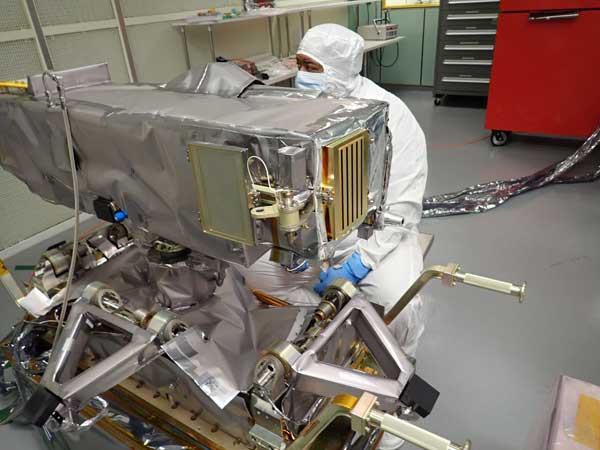
WASHINGTON – A joint-U.S. Naval Research Laboratory/NASA experiment prepares to investigate the origins of Solar Energetic Particles (SEPs) that could affect Navy satellites and harm personnel during future crewed missions to the moon and beyond.
Researchers will use a new instrument, the Ultraviolet Spectro-Coronagraph Pathfinder (UVSC Pathfinder) to try to understand the origins of these particles, how they’re generated close into the sun to provide accurate space weather forecasting when these events happen.
“These SEPs are the Sun’s most dangerous form of radiation, and they pose a major challenge to space exploration,” said Leonard Strachan Jr., Ph.D. an astrophysicist at NRL, and the mission’s principal investigator. “These powerful particles can wreak havoc with spacecraft and expose astronauts to dangerous radiation.”
UVSC Pathfinder rode to space aboard Space Test Program Satellite (STPSat)-6, the primary spacecraft of the Space Test Program (STP)-3 mission for the Department of Defense. STP-3 lifted off on Dec . 7 on a United Launch Alliance Atlas V 551 rocket from Cape Canaveral Space Force Station, Florida.
UVSC Pathfinder, as its name implies, is a pathfinder mission due to the new design of the coronagraph that uses five separate apertures, each with their own occulter that greatly improve the signal collected at the lowest regions of the Sun’s corona where the SEPs are first formed.
A coronagraph is a special type of telescope designed to block out direct light from the sun so that fainter, nearby regions in the corona are not washed out.
“First we need to prove that these work,” Strachan said. “We are trying to increase the effective collecting area of the instrument by a factor of 30. If we can prove it works, then we can think about how to miniaturize the instrument and possibly deploy them to multiple locations in the Solar System.”
As the United States prepares for the Artemis program and return of humans to moon for the first time since 1972, understanding the impact of SEPs on missions is imperative.
Just prior to Apollo 17, the last crewed mission to the moon, a large solar flare erupted with enough strength that it could have exposed astronauts to dangerous levels of radiation. Fortunately, the astronauts were not on the lunar surface.
“Apollo 17 would have been pretty serious if the coronal mass ejection would have been directed towards the moon,” Strachan said. “If we are going to have people working on the moon and in lunar orbit, they will need to know when to get into their protective shielding. So there are some true applications that will come out of this research, and not just scientific curiosity.”
While other NRL solar instruments, like the Wide-field Imager for Parker Solar Probe aboard NASA’s Parker Solar Probe and the Solar Orbiter Heliospheric Imager aboard ESA/NASA’s Solar Orbiter are moving about the inner solar system, UVSC Pathfinder will be in a near Earth geosynchronous orbit.
“The further out you go in space, the less data you can bring back because the transmission signal strength drops rapidly with distance and therefore it requires huge radio dishes to get the data,” Strachan said. “So being in a GEO orbit, we have a dedicated ground station at White Sands Missile Range, so we can get all of our data down, which is a major advantage.”
Strachan said this mission could not be accomplished without the team work at NRL and the collaboration between NASA and the DoD’s Space Test Program.
“The teams at NASA and the Space Test Program worked with us to get in on the satellite, so this is fortunate for us,” Strachan said. “We hope to have more opportunities to get experiments on as many rockets going up as possible in the future with this type of collaboration.”
UVSC Pathfinder flew alongside NASA’s Laser Communications Relay Demonstration, which is testing an enhanced communications capability with the potential to increase bandwidth to 10 to 100 times more than radio frequency systems — allowing space missions to send more data home.
UVSC Pathfinder was designed and built at the U.S. Naval Research Laboratory, and funded through NASA’s Heliophysics Program and the Office of Naval Research. It is managed by the Heliophysics Technology and Instrument Development for Science, or H-TIDeS program office at NASA Headquarters. The Space Test Program office at Kirtland Air Force Base in Albuquerque, New Mexico, is part of the U.S. Space Force’s Space Systems Command, headquartered at Los Angeles Air Force Base in El Segundo, California.
About the U.S. Naval Research Laboratory
NRL is a scientific and engineering command dedicated to research that drives innovative advances for the U.S. Navy and Marine Corps from the seafloor to space and in the information domain. NRL is located in Washington, D.C. with major field sites in Stennis Space Center, Mississippi; Key West, Florida; Monterey, California, and employs approximately 2,500 civilian scientists, engineers and support personnel.
– Advertisement –